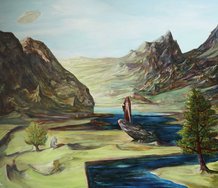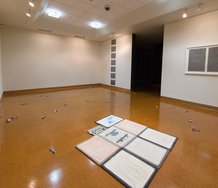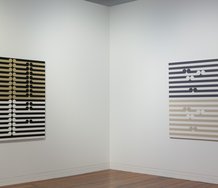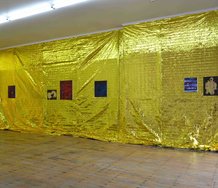Brendan Jon Philip – 27 April, 2017
Richards frames her whole attempt to express these practices of wellness in the world of contemporary art through a consideration of the phenomena of roundness as given form in the hikaru dorodango. The most perfect form of the sphere, subject to the clumsy complexities of actual being, of course only finds approximation in human hands. It is however the softened roundness of this approximation that is key.
Dunedin
Becky Richards
To watch, with your mind’s eye, the world floating quiet
5 - 29 April 2017
This current exhibition at the Blue Oyster Gallery centres itself around the Japanese craft practice of hikaru dorodango. Literally meaning ‘shining mud balls’ the practice, originally a children’s activity akin to making ‘mud pies’, has developed into a Zen-like meditative art form and in recent years and gathered a certain cachet in the West. The process as a whole involves selecting your dirt, mixing one’s clay from the sifted dust and water, and then taking the dedicated time to shape the resulting glob into as perfect a globe as possible. One then continues to refine the dorogando by removing moisture and smoothing the surface with dirt. The final part of the process involves polishing the surface to a fine lustre using fine particles of dust.
Richards eschews the shining part of her dorodango to focus instead on the psychological component of the physical act of getting one’s hands dirty and shaping the material earth. A few days prior to the exhibition’s opening she hosted a workshop - promoted via social media - in preliminary dorodango making for around twenty volunteer ‘co-creators’. The material part of this exhibition consists of the results and residue of this workshop: the dorodango nestled on comfy woollen blankets circling the raw materials of earth and water distributed about the centre of the room. About the walls are loosely spread handwritten notes consisting of responses from the workshop attendees to the making process and affirmations and instructions from Richards herself. The second gallery space holds a second workspace where the public are invited to sit for a spell of time and create their own hikaru dorodango.
Richards’ apparent motives in bringing this relational aspect of the workshop into her practice are to spread the sense of holistic wellbeing that comes from these immediate practices. The title of the exhibition - To watch, with your mind’s eye, the world floating quiet - makes the aim explicit. By determinedly taking the time, however momentarily, to contemplate and connect with the physical immediacy of the world we generate a beneficial state of psychological stillness. There is a lot in essence here comparable with techniques of mindfulness, promoted as a salve for the psychic aches and pains from the personal alienation that seems inherent our contemporary, electronically mediated world. There may be something to her method, to judge by the quietly pleased observations, recollections, and responses written by the workshop group.
The studious shaping of these mud balls leads to wistful childhood recollections and recalled fragments of experienced landscape as well as engaged answers to the task at hand. The overall indication being that those in the workshop group managed to achieve, through making their dorodango, a personally reflective and more meditative state more than when they entered into the process.
Richards frames her whole attempt to express these practices of wellness in the world of contemporary art through a consideration of the phenomena of roundness as given form in the hikaru dorodango. The most perfect form of the sphere, subject to the clumsy complexities of actual being, of course only finds approximation in human hands. It is however the softened roundness of this approximation that is key. As Bachelard notes in The Poetics of Space (1958), ‘Everything round invites a caress,’ roundness has a tactile as well as metaphysical appeal. It is in the synthesis between the experience of roundness of a physical category and as philosophical investigation that Richards’ programme of holistic wellness through mental stillness takes root.
Inherent in the ambitions of this show is the assumption that workshop attendees - indeed anyone who encounters the notion - will continue or take up their own practice of hikaru dorodango and ideally transmit the undertaking via word-of-mouth to those around them. The efficacy of this ongoing intention is difficult to measure (it is no fault of the exhibition that I personally have not made a dorodango yet - I promise I’m going to make time for it in my schedule), it is in some way heartening to witness a practice that offers solution to the wounds and distractions of culture.
Brendan Jon Philip
 Advertising in this column
Advertising in this column Two Rooms presents a program of residencies and projects
Two Rooms presents a program of residencies and projects



This Discussion has 0 comments.
Comment
Participate
Register to Participate.
Sign in
Sign in to an existing account.